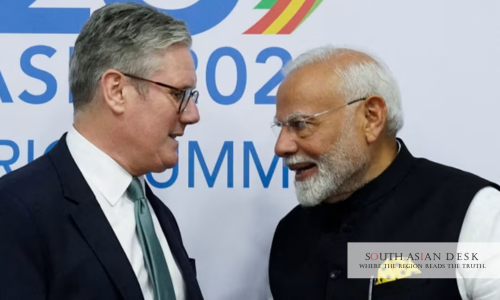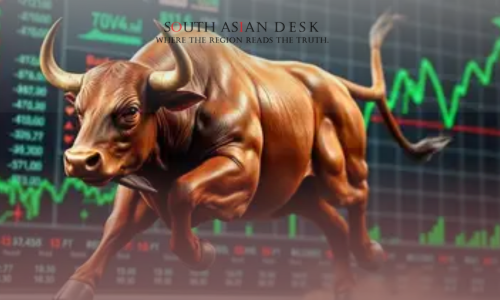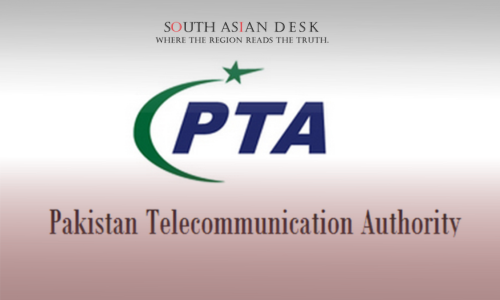MUMBAI, India – UK Prime Minister Keir Starmer arrived in Mumbai on Wednesday for a two-day visit where Starmer seeks India trade deal and signed in July 2025, accompanied by over 100 business leaders from sectors including energy and aviation. The trip, timed amid Keir Starmer India FTA visit October 2025, focuses on bilateral talks with Indian Prime Minister Narendra Modi on Thursday. It aims to accelerate implementation of the pact, which concluded after three years of negotiations in May 2025. Starmer seeks India trade deal benefits to drive UK growth, with events highlighting investment opportunities. Why now? Global tariff pressures, including from the US, have fast-tracked the agreement between the world’s fifth- and sixth-largest economies.
This India trade deal holds profound significance for South Asia, where India’s ascent as the third-largest global economy by 2028 could reshape regional trade dynamics. For nations like Pakistan, Bangladesh, and Sri Lanka, the UK-India pact signals a blueprint for post-Brexit-style deals that prioritise mutual market access in textiles, services, and manufacturing key pillars of South Asian exports. It underscores Britain’s pivot towards Asia amid faltering transatlantic ties, potentially easing supply chain strains exacerbated by recent US tariff hikes under President Donald Trump.
Economists project ripple effects: enhanced UK-India flows may boost intra-regional investments, fostering stability in a geopolitically volatile zone. Yet, for South Asian Desk audiences, the deal spotlights opportunities for diversified partnerships, urging local governments to negotiate similar pacts with London to counterbalance India’s gravitational pull. Starmer seeks India trade deal momentum not just for bilateral gains but to model equitable growth that benefits the broader subcontinent.
Keir Starmer India FTA Visit October 2025: Key Highlights
Starmer’s itinerary in Mumbai emphasises practical outcomes from the Keir Starmer India FTA visit October 2025. He landed on October 7, 2025, greeted by Indian Commerce Minister Piyush Goyal at Chhatrapati Shivaji Maharaj International Airport. The delegation includes executives from BP, Rolls-Royce, BT, British Airways, Manchester Airport, Diageo, and the Scotch Whisky Association. These firms represent high-growth areas like clean energy, aerospace, and consumer goods.
Bilateral discussions on Thursday will cover ratification timelines. Both governments target full implementation within the next year. The visit coincides with the deal’s post-signing phase, building on the July 24, 2025, ceremony in London where Modi and Starmer oversaw the signing by Goyal and UK Secretary of State for Business and Trade Jonathan Reynolds.
“It’s not just a piece of paper, it’s a launchpad for growth,” Starmer stated in a pre-visit address. He highlighted India’s economic trajectory: “The opportunities waiting to be seized are unparalleled.”
From the Indian side, a joint statement from the Ministry of External Affairs welcomed the visit as a “milestone in strategic partnership.” Officials noted the deal’s role in enhancing people-to-people ties, including eased visa norms for professionals.
Trade Deal Details: Tariffs, Access, and Projections
The India trade deal slashes tariffs on £28bn of bilateral goods trade. UK whisky exporters face reductions from 150% to 75%, phasing to 40% over 10 years. Indian textiles and automobiles gain reciprocal cuts, opening UK markets to £15bn in exports. Services liberalisation allows greater UK access to India’s IT and financial sectors, projected to add £10bn in annual flows.
Official data from the UK Department for Business and Trade estimates a 25.5 billion pounds ($34 billion) trade uplift by 2040. This marks the UK’s largest post-Brexit agreement, surpassing pacts with Australia and New Zealand combined. The July 24, 2025, Downing Street release detailed £6 billion in immediate investment wins, securing thousands of British jobs in aerospace and advanced manufacturing.
“Thousands of jobs created for Brits through new Indian investment and export wins worth almost £6 billion,” the Prime Minister’s Office announced. New figures show the £4.8bn trade deal will unlock economic growth across every UK region, aligning with the government’s Plan for Change.
On the Indian front, the Press Information Bureau highlighted the pact’s balance. It eases UK imports of components for luxury goods while protecting sensitive sectors like agriculture. Bilateral trade hit £38.8 billion in 2024-25, up 10% year-on-year, per commerce ministry data.
Starmer seeks India trade deal synergies in green tech. BP pledged £1.2 billion for Indian renewable projects, while Rolls-Royce eyes joint ventures in sustainable aviation. These commitments stem from the deal’s environment chapter, mandating net-zero alignment.
Business Delegation: Driving Keir Starmer India FTA Visit October 2025 Investments
Over 100 delegates amplify the Keir Starmer India FTA visit October 2025 impact. British Airways announced a third daily Heathrow-Delhi flight for 2026, boosting passenger traffic by 20%. Manchester Airport partners with IndiGo for a new Delhi route, targeting 500,000 annual travellers.
Diageo and the Scotch Whisky Association lobbied for tariff relief, now realised. “This deal transforms our market access,” said a Diageo spokesperson.
Cultural and academic ties feature prominently. University leaders from Oxford and Cambridge seek collaborations in AI and biotech, leveraging the deal’s education mobility provisions. Over 50,000 Indian students already study in the UK; the pact aims to double this by 2030.
For South Asia, these moves signal broader opportunities. Pakistan’s textile exporters, facing 12% UK duties, may pursue similar negotiations. Bangladesh could benefit from supply chain integrations, as Indian firms onshore production under the FTA.
Background: Path to the India Trade Deal
Negotiations began in January 2022 but stalled over visa and dairy issues. Resumption in February 2025, post-G20 sidelines talks between Modi and Starmer, accelerated closure. The May 5, 2025, UK announcement hailed a “multi-billion-pound boost,” with tariffs liberalised on 90% of goods.
The July signing unlocked £4.8 billion in direct economic value, per HM Treasury models. This includes £2.2 billion in annual wages from export growth. India’s commerce ministry reported symmetric gains, with £3.5 billion in new service revenues.
Global context propelled urgency. US tariffs on steel and whisky, imposed in 2025, hit UK exporters hard. The India deal offsets this, redirecting 15% of affected trade volumes.
What’s Next: Ratification and Beyond
Ratification processes launch in Q1 2026, with parliamentary approvals targeted for March. Implementation phases roll out tariff cuts over five years. Starmer seeks India trade deal expansion into digital trade and defence co-production.
Future visits include Modi’s return to London in 2026. Joint working groups on climate and migration will convene quarterly. Analysts forecast 8% annual trade growth, outpacing global averages.
As Starmer departs Mumbai, the Keir Starmer India FTA visit October 2025 lays groundwork for enduring ties. Starmer seeks India trade deal as a cornerstone of UK foreign policy, promising sustained prosperity for both nations and South Asia at large.
Published in SouthAsianDesk, October 8th, 2025
Follow SouthAsianDesk on X, Instagram, and Facebook for insights on business and current affairs from across South Asia.






